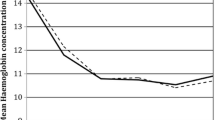Abstract
We investigated the effects of tranexamic acid in 40 patients who had received cementless total hip arthroplasty (THA) in a prospective, randomized study. In 20 patients, 1000 mg of whole-body tranexamic acid was administered intravenously 5 min before the operation started. The other 20 patients served as a control group and were operated on without tranexamic acid. Perioperative blood loss was similar in the tranexamic acid group and in the control group. Postoperative blood loss of the tranexamic acid group was significantly less than that of the control group at 2, 4, 6, 8, 10, and 12 h. Regarding time-related changes of postoperative blood loss, significant reduction was observed during the first 2 h after surgery in the tranexamic acid group (P<0.001). After the first 2 h, there was no significant difference between the tranexamic acid group and the control group. Preoperative administration of tranexamic acid decreased postoperative blood loss until 12 h and total bleeding in cementless THA by reduction of blood loss during the first 2 h after surgery.
Résumé
Dans une étude prospective et randomisée nous avons enquêté sur les effets de l’acide tranéxamique chez 40 malades qui avaient reçu une PTH sans ciment. Chez 20 malades, 1000 mg/d’acide tranéxamique ont été administré par voie intraveineuse cinq minutes avant l’opération. Les autres 20 malades ont fait office de groupe témoin et ont été opérés sans acide tranéxamique. La perte de sang peropératoire était semblable dans le groupe acide tranéxamique et dans le groupe témoin. La perte de sang postopératoire du groupe acide tranéxamique était notablement plus faible que celle du groupe témoin à 2, 4, 6, 8, 10, et 12 heures postopératoires. En considérant les modifications de la perte sanguine en fonction du temps postopératoire, une réduction significative a été observée dans les deux premières heures dans le groupe acide tranexamique (P<0.001). Après les 2 premières heures, il n’y avait pas de différence entre le groupe acide tranéxamique et le groupe témoin. L’administration préopératoire d’acide tranéxamique a diminué la perte de sang postopératoire jusqu’à 12 heures et le saignement total dans les PTH sans ciment par réduction du saignement pendant les 2 premières heures après chirurgie.


Similar content being viewed by others
References
Ali IM, Landymore RW (1994) The use of tranexamic acid in cardiac operation (letter). J Thorac Cardiovasc Surg 107:1377
Benoni G, Fredin H (1996) Fibrinolytic inhibition with tranexamic acid reduces blood loss and blood transfusion after knee arthroplasty: a prospective, randomized, double-blind study 86 patients. J. Bone Joint Surg [Br] 78: 434–440
Benoni G, Carlsson A, Petersson C, Fredin H (1995) Does tranexamic acid reduce blood loss in knee arthroplasty? Am J Knee Surg Summer; 8:88–92
Benoni G, Lethagen, S, Nilsson P, Fredin H (2000) Tranexamic acid, given at the end of the operation, does not reduce postoperative blood loss in hip arthroplasty. Acta Orthop Scand 71:250–254
Charrois O, Kahwaji A, Vastel L, Rosencher N, Courpied JP (2001) Blood loss in total hip arthroplasty for destructive coxarthrosis. Int Orthop 25:22–24
Christie J, Robinson CM, Pell AC, McBirnie J, Burnett R (1995) Transcardiac echocardiography during invasive intramedullary procedures. J Bone Joint Surg [Br] 77:450–455
Dahl OE. The role of the pulmonary circulation in the regulation of coagulation and fibrinolysis in relation to major surgery (1997) J Cardiotholac Vasc Anesth 11:322–328
Dunn CJ, Goa KL. Tranexamic acid: a review of its use in surgery and other indications (1999) Drugs 5:1005–1032
Ekbäck G, Axelsson K, Ryttberg L, Edlund B, Kjellberg J, Weckström J, Carlsson O, Schött U (2000) Tranexamic acid reduces blood loss in total hip replacement surgery. Anesth. Analg 91:1124–1130
Farmy NR, Patel DG. Hemostatic changes and postoperative deep-vein thrombosis associated with use of a pneumatic tourniquet. (1981) J Bone Joint Surg [Am] 63:461–465
Hiippala S, Strid L, Wennerstrand M, Arvela V, Mantyla S, Ylien J, Niemala H (1995) Tranexamic acid (Cyclokaplon) reduces perioperative blood loss associated with total knee arthroplasty. Br J Anaesth 74:534–537
Ido K, Neo M, Asada Y, Kondo K, Morita T, Sakamoto T, Hayashi R, Kuriyama S (2000) Reduction of blood loss using tranexamic acid in total knee and hip arthroplasties. Arch Orthop Trauma Surg 120:518–520
Janssens M, Joris J, David JL, Lemaire R, Lamy M (1994) High-dose aprotinin reduces blood loss in patients undergoing total hip replacement surgery. Anesthesiology 80:23–29
Mongan PD, Brown RS, Thwaites BK (1998) Tranexamic acid and aprotinin reduce postoperative bleeding and transfusions during primary coronary revascularization. Anesth Analg 87:258–265
Nakao A, Sakoh T, Takimoto H, Itoh N, Yamamoto F, Sawada K (1979) Perioperative kinetics of plasminogen activator and antiplasmin, and antifibrinolytic action of trans-AMCHA. J Clin Exp Med 56: 998–1001
Nilsson IM (1980) Clinical pharmacology of aminocaproic and tranexamic acids. J Clin Pathol (R Coll Pathol.) (Suppl) 14:41–47
Reid RW, Zimmerman AA, Laussen PC, Mayer JE, Gorlin JB, Burrows FA (1997) The efficacy of tranexamic acid versus placebo in decreasing blood loss in pediatric patients undergoing repeat cardiac surgery. Anesth Analg 84:990–996
Risberg B (1985) The response of the fibrinolytic system in trauma. Acta Chir Scand Suppl 522:245–271
Sano K, Hakumizu H, Kojima T, Akimoto K (1976) Absorption and excretion of tranexamic acid in human; Clin Pharmacol Ther 7:375–382
Shore-Lesserson L, Reich DL, Vela-Cantos F, Anmar T, Ergin MA (1996) Tranexamic acid reduces transfusions and mediastinal drainage in repeat cardiac surgery. Anesth Analg 83:18–26
Author information
Authors and Affiliations
Corresponding author
Rights and permissions
About this article
Cite this article
Yamasaki, S., Masuhara, K. & Fuji, T. Tranexamic acid reduces blood loss after cementless total hip arthroplasty—prospective randomized study in 40 cases. International Orthopaedics (SICOT) 28, 69–73 (2004). https://doi.org/10.1007/s00264-003-0511-4
Accepted:
Published:
Issue Date:
DOI: https://doi.org/10.1007/s00264-003-0511-4




